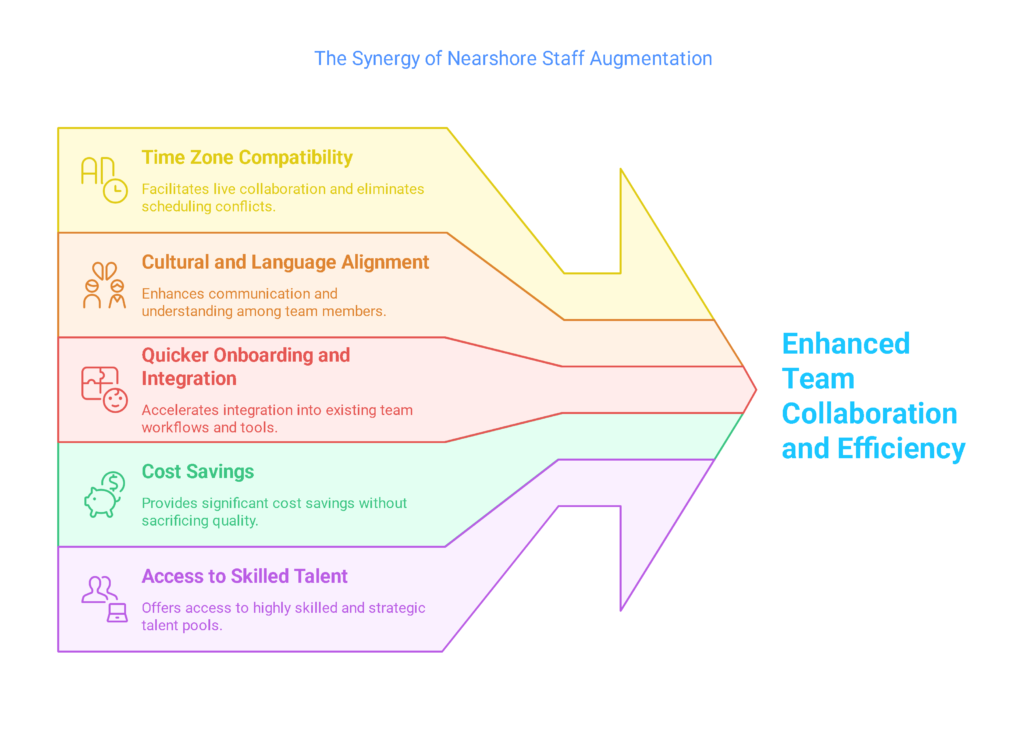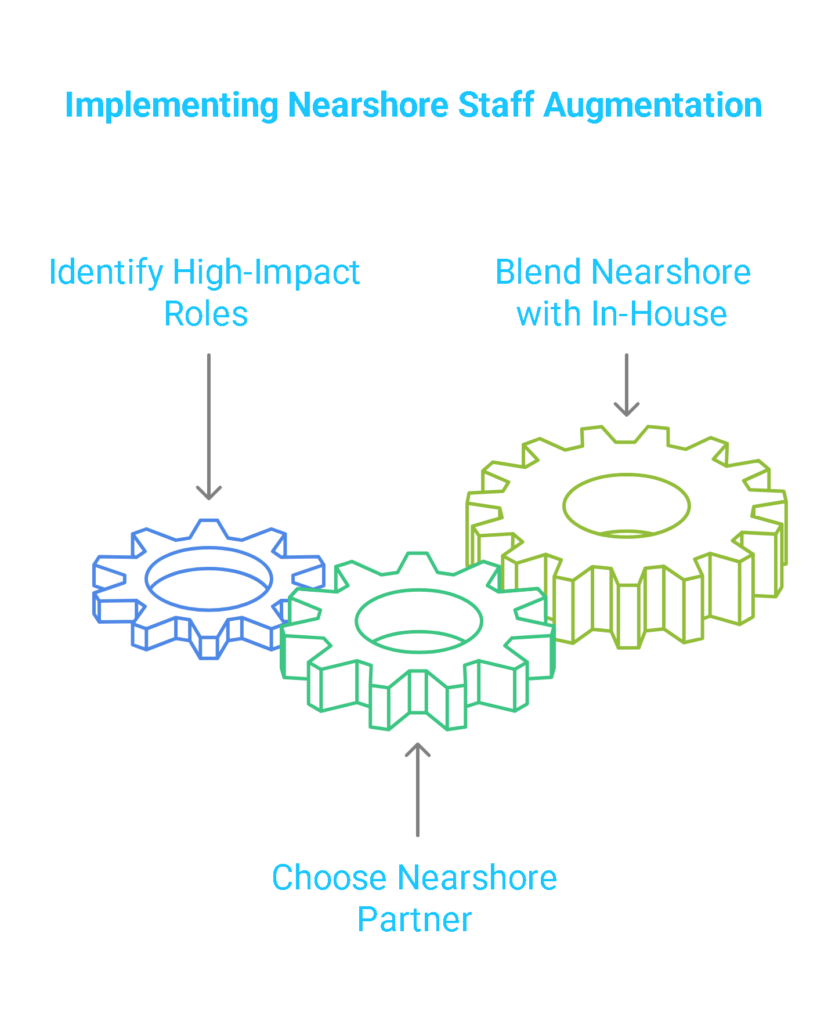Introduction
Staff Augmentation Services have long been associated with offshore development—outsourcing work to countries far from HQ to save on costs.
But in 2025, a new trend dominates the tech talent conversation: Nearshore is the latest offshore.
Smart companies are shifting from distant time zones and cultural disconnects to nearshore partners—countries that are geographically and culturally closer. And for good reason: today’s businesses demand agility, speed, and tight collaboration—something offshore often fails to deliver.
In this blog, we’ll explore:
✅ Why nearshore is overtaking offshore in 2025
✅ The biggest benefits of nearshore Staff Augmentation Services
✅ How to implement a nearshore-first strategy
✅ What this means for your scaling roadmap
Let’s unpack this shift and what it means for your next growth phase.
The Offshore Model Is Cracking Under Modern Demands
For many years now, offshore models through Staff Augmentation Services have been associated with low-cost developers from distant locations such as India, the Philippines, or Eastern Europe. While the potential cost savings were real, so were the challenges that came with offshore development:
The offshore pain points:
- Inconsistent time zones (8–12 hours difference)
- Language barriers and cultural disconnect
- Asynchronous feedback loops cause delays
- Difficulty integrating outsourced developers into core teams
In 2025’s high-speed product cycles, offshore lag time can significantly impact team velocity and quality.
Nearshore Staff Augmentation Services
What Is Nearshore Staff Augmentation?
Nearshore Staff Augmentation Services refer to hiring developers or teams from countries that are geographically close and share overlapping time zones.
Examples:
- U.S. companies hiring from Latin America
- Canadian companies working with Brazil, Colombia, or Mexico
- European firms nearshoring to Poland or Portugal
This hybrid model combines the cost-effectiveness of outsourcing with the agility of in-house collaboration.
Why Nearshore Is Winning in 2025
1. Time Zone Compatibility = Live Collaboration
With nearshore Staff Augmentation Services, your team can:
- Join live daily standups
- Respond to issues in real time
- Eliminate awkward late-night or early-morning meetings
This results in better productivity, fewer miscommunications, and a more agile development cycle.
2. Cultural and Language Alignment = Better Communication
Nearshore developers typically offer:
- English or French fluency
- Shared professional values such as transparency, ownership, and responsiveness
- Familiarity with agile methodologies
These attributes make nearshore Staff Augmentation Services a more seamless extension of your internal team.
3. Quicker Onboarding and Integration
Nearshore engineers:
- Adapt faster to your workflows (Slack, Jira, Zoom)
- Fit into your sprint cycles from day one
- Are perceived as part of your core team, not “just” contractors
This faster integration drives immediate value.
4. Cost Savings—Without the Offshore Trade-Off
Yes, Staff Augmentation Services from nearshore regions still cost 30–50% less than hiring locally. But unlike offshore options, nearshore teams:
- Reduce rework through better communication
- Provide higher output per hour
- Enable faster project turnaround
So, you’re saving money and gaining speed.
5. Access to a Highly Skilled, Underrated Talent Pool
Regions like Latin America, Eastern Europe, and Southeast Asia offer:
- Highly skilled, bilingual engineers
- Experience in fast-paced SaaS, fintech, AI, and cloud projects
- Strategic thinking, not just coding skills
This makes nearshore Staff Augmentation Services ideal for scale-ups and enterprises alike.

How to Build a Nearshore-First Staff Augmentation Strategy
Step 1: Target High-Impact Roles
Start with roles that:
- Require strong collaboration (e.g., full-stack devs, QA, support)
- Need speed and flexibility (e.g., DevOps, product engineers)
- Benefit from time zone alignment (e.g., client-facing staff)
These are top candidates for nearshore Staff Augmentation Services.
Step 2: Choose the Right Nearshore Partner
The right provider should offer:
- Time zone overlap
- Strong communication and language skills
- Proven experience with agile and remote teams
- Cultural onboarding resources
Codepaper Technologies specializes in delivering nearshore Staff Augmentation Services tailored for North American startups and scale-ups, ensuring speed, integration, and ownership.
Step 3: Blend Nearshore With In-House Teams
Think beyond outsourcing—think team expansion.
Your nearshore team should:
- Participate in daily meetings
- Use your collaboration tools
- Follow your product roadmap
With this approach, Staff Augmentation Services act as a force multiplier, not a cost center.

Conclusion: Nearshore Isn’t Just a Trend—It’s the Future of Team Building
In the 2010s, offshore helped tech businesses scale. But in 2025, the demands are different:
- Faster releases
- Closer collaboration
- Agile pivots
- Human-centered innovation
Nearshore staff augmentation answers those demands, delivering local hiring speed with the flexibility and savings of offshore.
Not surprisingly, savvy CTOs, founders, and product leaders are transitioning to this model.
🚀 Looking to localize your team with expert nearshore developers?
Talk to the team at Codepaper Technologies and let’s build a smarter, faster team together, with our proven nearshore staff augmentation services.
Frequently Asked Questions (FAQs)
1. What is the difference between nearshore and offshore staff augmentation?
Nearshore refers to staff in nearby countries in similar time zones, while offshore describes staff in farther away countries. Nearshore gives you the benefit of working with teams much faster and without language barriers, as well as with similar savings on costs.
2. Why are companies migrating from offshore to nearshore in 2025?
Real-time communication, a workforce that has the same agility as companies in North America, and a stronger product integration are catalysts for this migration, coupled with the fact that nearshoring offers solutions to the challenges of offshoring but maintains most savings on costs.
3. What regions are considered “nearshore” for North American companies?
Technically, anywhere in the Americas is considered nearshore, but popular nearshore locations would be Latin America: Mexico, Colombia, Brazil, Argentina, with the same time zone, cultural affinity, and experienced engineers.
4. Is nearshore staff augmentation more expensive than offshore?
It could be slightly more cost per hour. However, due to the productivity and improved alignment, nearshore development teams are always more productive, resulting in improved project efficiency, and depending on the RO,I you can fast-track projects.
5. Can nearshore engineers act as dedicated team members?
Definitely. Many nearshore developers work with the client’s company as full-time staff; they attend internal meetings and contribute to the project as if they were internal employees, but are just in another country.